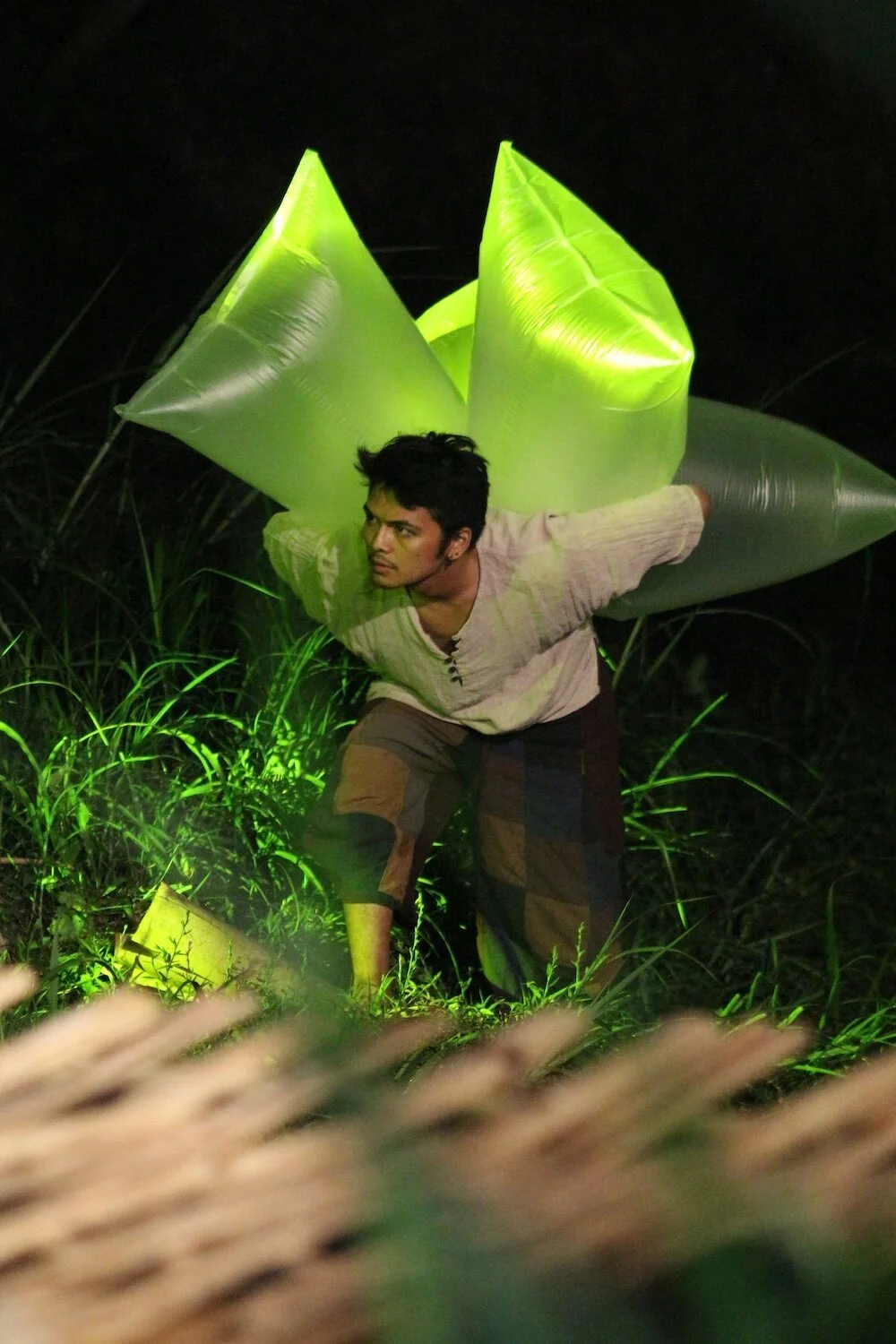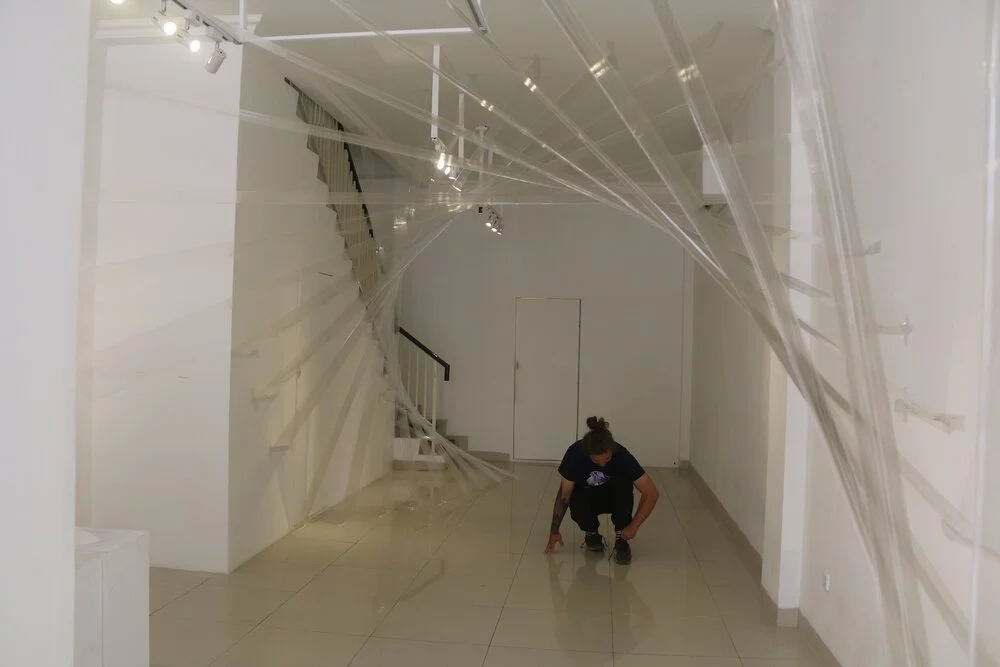Fresh Face: Aziz Amri
Performing the personal and the political
A&M's Fresh Face is where we profile an emerging artist from the region every month and speak to them about how they kick-started their career, how they continue to sustain their practice and what drives them as artists.
Aziz Amri.
Interpreting power structures through the viscerality of performance steers Jakarta-based Aziz Amri’s (b. 1994) practice. While the artist works across a range of media including illustration and photography, his live pieces hold a prominent spot in his oeuvre. His fondness for this medium can be further discerned from the artist-run space that Aziz co-founded, Sepersepuluh, where performance art is its main focus.
Aziz Amri, Laurel Wreath: Evolution, 2018, performance, 45 min. Photograph by Kelvin Atmadibrata, image courtesy of the artist.
It is at Sepersepuluh where Aziz held his first two solo exhibitions, Hyaline (2017) and Laurel Wreath (2018). Outside of this space, he has also participated in numerous exhibitions and festivals both within Indonesia and abroad, including the solo Black Magic (2019) at Giant Dwarf, Manila, Melaka Art and Performance Festival 2017, and Bandung International Art Festival 2019.
The artist’s interest in decoding power structures stems from making sense of his personal experiences and encounters, which he extrapolates to pervasive social issues. For his performance, They Say Things where he crams translucent straws into his mouth to the point of choking, Aziz demonstrates the psychological repercussions of rigidly following the status quo in spite of one’s deviating inclinations. And as with this genre of art where the object is just as agential as the body, the straws function goes beyond that of a mere prop. Rather, they partake in the meaning-making process as an aggressive force bearing down on the artist’s body. At the same time, their translucency alludes to the “invisible” factor of such forces in society. While inspired by his own conventional upbringing, the artist also views this as a widespread phenomenon where normative expectations insidiously suffocate personal choices.
Aziz Amri, Neuron, 2019, performance. Image courtesy of the artist.
For Aziz, the preparation forms an important foundation for his performance, and much care and effort goes into conducting research before its eventual execution. His upcoming work on food in relation to the senses and memory saw him staying in multiple villages for months on end so as to thoroughly understand the various facets of his subject matter. Behind this level of commitment to his craft is a resolute belief of the universality of art, and its capacity to drive social change.
Interview
Aziz Amri, Jardin Zoologique D'Acclimatation, 2018, mixed media installation and performance. Image courtesy of the artist.
You obtained a Bachelor of Computer Science from Islamic State University, Jakarta. Could you talk more about how you transitioned from this to making art? And at what point in your life did you decide to pursue a career in this field?
I had a monotonous life from growing up in a conservative family and having majored in Computer Science. This established a mindset of logic and rules, and the essence of living colourfully was missing. My experience triggered feelings of wanting more: something adventurous, momentous and spontaneous. I believe this is my true nature.
Art was the answer. I was enlightened with regard to my position in society, and I finally felt like I belonged.
Could you share how you’ve maintained your practice after getting into the art scene? What are the important factors that kept you going?
There are things that cannot be described with words, hence, expressing myself through my art was the way forward. I buried many feelings, experiences and life lessons that may not be understood conventionally, so performance art became the platform to communicate these tangled thoughts. It encourages the body to move as wildly as it can, and it has become an “addiction” that has fuelled my desire to create and perform. Through this process, my art serves as a healing process as well.
Sepersepuluh, Jakarta. Image courtesy of the artist.
You currently co-run the performance art-focused space, Sepersepuluh, Jakarta. Can you talk about how this came to be, and how it has influenced your own practice?
Sepersepuluh is meant to be a bridge for all kinds of possibilities in art through this medium, and it was founded as there were hardly any other such spaces in the country.
Sepersepuluh is a gallery that encourages experimentation, but its main focus is on performance. Since the medium is still growing and not many people know about it in Indonesia, the intention of the space is to introduce the practice to the public through exhibitions, discussions, workshops and community gatherings.
Aziz Amri, Hyaline, 2017, performance with bubble wrap and plastic sealer, 150 min. Photography by Yudi Noviansyah, image courtesy of the artist.
On that note, you also had your first solo exhibition, Hyaline, at Sepersepuluh. What was the process like preparing for it, and the learning opportunities and challenges faced?
As an emerging artist who is trying to build his portfolio, having my show at my own space was the answer, especially when putting up a work that other galleries might be keen to show.
Preparing in my own gallery was a relatively easy process. The challenges came from having to gather an audience and making sure that the exhibition was of standard in comparison to other galleries. Luckily, with the help of two brilliant artists, we formed a proper showcase based on their experiences and expertise. We then applied our learning points from ‘Hyaline’ for our subsequent exhibitions and programmes so as to create an enjoyable experience for our audience.
Who has been a mentor or what has been an important artistic influence? And why?
My gallery co-founders are my mentors. They have taught me to see from different perspectives and how to look from an artistic point of view. Exchanging thoughts with my co-founders has also made me understand and appreciate art so much more. Particularly for performance, I came to understand that the body is the medium and every single detail must contain a certain meaning, hence, creating a work is not instantaneous. It requires research, time and commitment, just like crafting a journal.
Aziz Amri, Interaction (detail), 2018, digital print on cardboard as performance documentation. Image courtesy of the artist.
What was an important piece of advice you were given?
The first: “Being an artist means being committed towards your art. You must be committed to create works constantly and be responsible for your practice”. And the second: “If you want to be a rebel, then so be it, but always be the best at what you do.”
These are the two strongest pieces of advice I received before I started my practice. It pushed me to make good work and to keep moving forward.
Could you share your favourite art space or gallery in Indonesia? Why are you drawn to that space and what does it offer you?
Rumah Tangga in West Java, as it is an honest space that encourages us to make artworks for ourselves and not to impress others, and it is known to be a safe space by everyone. It also encourages the mindset of valuing artworks and people not from a capitalistic viewpoint but rather, from the honesty of one’s work and how we perceive the world soulfully. Art should be fun and beautiful.
What are your hopes for your own local art scene, and regionally as well?
I hope that art can be better appreciated and welcomed on a larger scale in society, and that being an artist is a job that can be taken seriously.
Are there any upcoming projects that you would like to share more information on?
I am preparing for a work that involves the senses and memory with food as the instrument, and it will involve multiple facets of society. I have been working on this for the last two years, and have been gathering information on food in relation to lifestyles. I travelled to many different villages and stayed for months to research the meanings of food served. I also decided to participate in the cooking competition, Masterchef Indonesia, to understand this from a media’s point of view. Indeed, the vital part of the work is to gather as many perspectives as possible. Hopefully, it will be ready by next year. I am excited to exhibit it soon.







